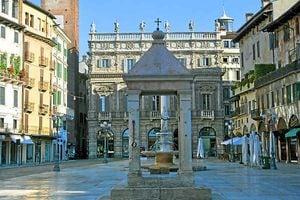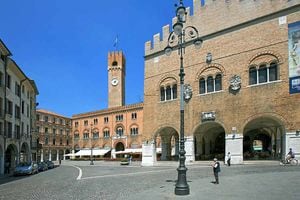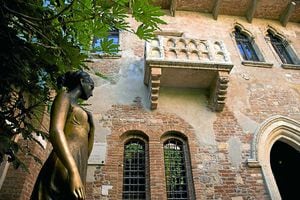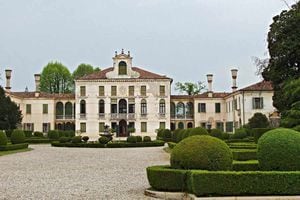Holiday Review: Veneto, Italy
It's not every day that you get to dine with a count.

As I sit next to Count Alberto Passi de Preposulo, a striking older gentleman with a manicured white beard, I feel privileged at first as he recounts the various foibles associated with his cast.
He heads one of Italy's oldest (and most nobly decorated) families. Yet times are changing, and now the count is promoting the use of his home – Villa Tiepolo Passi – as a restaurant and hostel.
The villa in question is situated in Treviso in Italy's Veneto region and dates back to the early 16th century.
Earlier that day I'd been shown around by his dreamy son, Gian Luca (who, alas, has already been snapped up by none-other than Zero Dark Thirty star Jessica Chastain) and equally stunning daughter Gaia. They pointed out secret passageways, cherubic frescoes and a family tree dating back to 600 AD.
Outside, competing with the majesty of the house is a sprawling garden, comprised of hedges weaved into geometric patterns, over 150 species of trees and shrubs – some centuries old – and a farm and vineyard, both of which contribute to the Count's pantry, and make up the menu for dinners regularly hosted on the property.
Count Alberto personally finds local poets and musicians to perform, and the food – all organic and sourced on site – is made from family recipes. Home-bottled prosecco and jam feature heavily. These cultural meals are priced at a surprisingly reasonable €30.
The idea that the count would open up his home to a bunch of ogling strangers may seem odd. Count Alberto is forthright when describing his logic.
"Our money is finished," he laments over dinner – referring not just to his own financial standing, but to that of the Italian aristocracy in general.
"It's impossible to maintain the house. You see, I'm trying to protect the richness of our history, our roots, but," he sighs, "it's expensive."
Count Alberto is heading an interesting movement. He is the president of the Ville Venete project, a kind of conglomerate of landed gentry willing to open up their home for a price, be it in the form of a guided tour, sit-down dinner, adventure experience, or, in a few instances, overnight stays.
There are more than 4,000 villas in the Veneto region, an area that makes up some of the country's most visited tourist spots, including Venice, Verona and Padua. Of these, about 150 are accessible to the public. Sampling the lifestyle of the rich and famous has never been so easy.
For anyone who wants to know what it's like to live in a villa, they can book a room at Villa Corner Della Regina. The 17th-century estate was originally build for a nobleman's daughter who later become queen of Cyprus. It was since purchased by an Australian-born Italian, who has converted it into a hotel.
The rooms are incredibly inconsistent, but that adds to its charm. Some come decorated with family portraits, or fading frescoes; some are apartment-sized, others resemble the serving quarters.
An hour outside of Verona – where queues of tourists wait to see Juliet's famous balcony (if Romeo had known how his martyred love would be maligned after his death, he might have thought better of that poison) – sits Villa Valmarana. The 16th century structure is stunning, though it's the interior that truly dazzles. Inside, the walls are covered with frescoes painted by Giambattista Tiepolo and his son Giandonenico.
Frescoes
The colours are so bright, you'd think they were painted yesterday. The villas was owned by a lawyer in mourning over the death of his wife, and the frescoes correspondingly depict acts of duty, and tragic tales of love lost.
The estate's owner, Countess Carolina Valmarana, lets visitors tour her home for a small fee (€5-10, depending on the season). She has also set up a café serving coffee and pastries that overlooks the family chapel (a common feature on such properties). Until recently, you might have found Countess Carolina stocking the café fridge herself, but she abandoned manning the stocks. The villa gets 30,000 visitors a year, and hosts ten weddings and 30 dinners.
"The money we charge pays the mortgage; not a penny goes into our pocket," she explains. For her, managing the villa is a question of upkeeping one of Italy's historical and cultural landmarks, though she may be the last in her generation to see it that way.
"My daughter says, 'mum, when you die, can I sell the villa?'" she laughs, but she's shaking her head.
In her generation, at least, villa maintenance is a family practice. Nearby, her cousin, Nicolo Valmarana, owns Villa La Rotonda, a 16th century masterpiece that is considered the epitome of Palladian architecture. Palladian, of course, refers to buildings created by Andrea Palladio, a miller's son from Padua who went on to inspire generations of architects around the globe.
Count Nicolo says he wanted this building to resemble a living, breathing entity, so he created a quartz-based plaster for the exterior. The result is that the structure changes colour with the time of day.
The house is almost like a reverse-Tardis. From the outside, it looks like a monolithic mansion. Inside, the rooms are actually quite small – the space was built in 1565 for a retired Vatican priest, and had single-person living in mind.
"It's like meeting someone," says Nicolo. "You form an external opinion, then you get to know their many depths."









